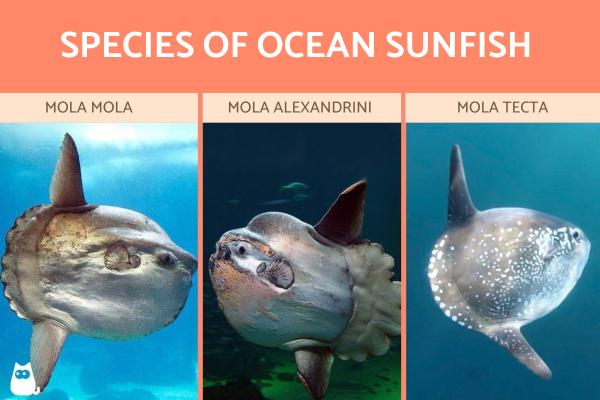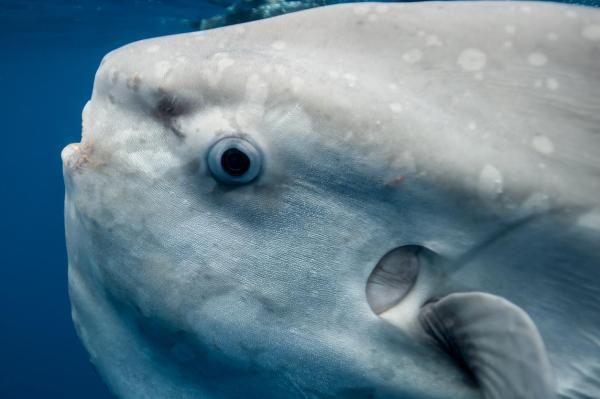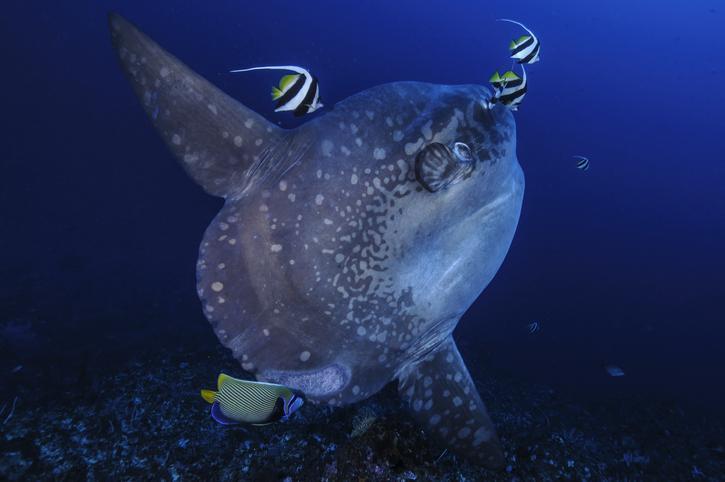Ocean Sunfish or Mola - The World’s Heaviest Bony Fish


The ocean sunfish, also known as the mola, is one of the most fascinating and unique fish species in the world. With its distinctive flattened shape, long dorsal fins, and enormous size, the sunfish has captured the imagination of marine biologists and casual observers alike. Despite its impressive appearance, the sunfish is known for its docile and inquisitive behavior, making it a popular subject for divers and snorkelers.
In the following AnimalWised article, we will explore the fascinating world of the ocean sunfish and learn more about its habitat, diet, reproduction, and conservation status.
Taxonomic classification of the ocean sunfish
The ocean sunfish, or Mola mola, is a species of fish that belongs to the family Molidae. Here is the full taxonomic classification of the sunfish:
- Kingdom: Animalia
- Phylum: Chordata
- Class: Actinopterygii
- Order: Tetraodontiformes
- Family: Molidae
The Molidae include the molas or ocean sunfish, unusual fish whose bodies end just behind the dorsal and anal fins, giving them a semi-fish appearance. Only five extant species in three extant genera are described:
- Ocean sunfish (Mola mola)
- Southern ocean sunfish (Mola alexandrini)
- Hoodwinker sunfish (Mola tecta)
- Slender sunfish (Ranzania laevis)
- Sharptail mola (Masturus lanceolatus)
You may be interested in this other article, where we explain the classification system of the 5 kingdoms.

Main characteristics of the ocean sunfish
The ocean sunfish (Mola mola) is a unique and fascinating fish for several reasons:
- The ocean sunfish is the heaviest bony fish in the world, with an average weight of 1,000 kg (2,200 lbs) and a maximum weight of up to 2,300 kg (5,000 lbs). It can grow up to 3.3 meters (11 feet) in length and 4.2 meters (14 feet) in height, making it one of the largest fish species in the world.
- There is sexual dimorphism in this species, as females are larger than males.
- The ocean sunfish has a distinctive appearance, with a flattened body that resembles a disk, and a long, pointed snout.
- Its skin is covered with a layer of mucus, and it has no scales.
- The fins of the sunfish also have distinctive characteristics, as it lacks a fin and caudal peduncle. Instead, it has a fan-shaped structure called a clavus, which is a tail that provides propulsion.
- The fish is also known for its large, almost circular dorsal and anal fins, which it uses to swim and steer.
- Ocean sunfish are primarily solitary and slow-moving fish that spend most of their time near the surface of the water. They are often seen basking in the sun or floating on their sides, appearing almost motionless. They are also known to dive to depths of up to 600 meters (ca. 1,969 ft) in search of food.
Continue reading in this other article where we discuss if all fish have scales?

Can you eat ocean sunfish?
Although ocean sunfish is sometimes consumed as a food in some cultures, it is generally not considered a desirable or common food source. In some countries, such as Taiwan and Japan, sunfish is occasionally served as a delicacy, often in the form of sashimi. However, the meat is generally not widely available or consumed, as the flavor is considered rather bland, and the texture is often described as rubbery.
Where does the ocean sunfish live?
The habitat of the sunfish is very diverse, being a cosmopolitan species. It can be found in temperate and tropical waters around the world, including the Atlantic, Pacific, and Indian Oceans.
Ocean sunfish are pelagic fish, meaning they spend most of their time in the open ocean, far from the seafloor. However, it occasionally moves to coral or algal formations to rid itself of parasites with the help of fish from the wrasse group, which then removes them.
They often stay in surface waters, where they bask in the sun to regulate their body temperature. They are also capable of diving to depths of up to 2,000 feet (0.61 km) in search of food.
What does the ocean sunfish eat?
The ocean sunfish feeds primarily on jellyfish, but it also eats other types of planktonic organisms, small fish, squid, and crustaceans.
Despite its size, the ocean sunfish has a relatively small mouth, so it uses a special feeding technique to catch its prey.
When feeding on jellyfish, the sunfish swims toward the jellyfish and devours it with its large, circular mouth like a vacuum cleaner. It can swallow jellyfish up to 3 feet (ca. 91 cm) in diameter.
The sun jellyfish can feed on jellyfish without being stung by its tentacles because it has a thick layer of mucus that protects its skin.
In addition to jellyfish, the ocean sunfish also feeds on other gelatinous organisms such as salps and ctenophores, as well as small fish and squid. It is also known to feed on dead animals and eat floating debris such as plastic and seaweed.
The ocean sunfish has a highly specialized digestive system that allows it to efficiently extract nutrients from its food. It has a long intestine that rolls up inside its body and can process large amounts of food quickly. Despite its ability to absorb large amounts of food, the ocean sunfish has a relatively low metabolic rate and does not need to eat frequently.

How does the ocean sunfish reproduce?
Oceanic sunfish reproduce by spawning. They are oviparous, meaning that females lay eggs that are fertilized by males. During spawning, a female sunfish releases millions of tiny eggs into the water, which are fertilized by the sperm of one or more males. The eggs then float in ocean currents, where they develop into larvae.
Ocean sunfish larvae are tiny and translucent and have a gelatinous body that allows them to float in the water. They drift with ocean currents for several months before settling in shallow waters. As they grow, they develop the characteristic disk-shaped form of the adult sunfish.
Little is known about the reproductive behavior of sunfish, as mating and spawning have rarely been observed in the wild. However, scientists have been able to study sunfish reproduction in captivity, which has provided some insight into the reproductive biology of this species.
Female sunfish are capable of producing up to 300 million eggs at a time, making them one of the most prolific fish species in the ocean. However, the vast majority of these eggs do not survive to adulthood because they are eaten by predators or do not develop properly. As a result, sunfish populations are highly vulnerable to decline due to overfishing or other threats.
You may be interested in this other article where we discuss how fish are born.
Protection status of ocean the sunfish
The conservation status of the ocean sunfish is currently classified as "vulnerable" by the International Union for Conservation of Nature (IUCN). This means that the species is at high risk of extinction in the wild in the near future.
The ocean sunfish faces a number of threats, including overfishing, accidental entanglement in fishing gear, ingestion of marine debris, and habitat destruction. Because the ocean sunfish is a slow-moving and curious fish, it is also highly susceptible to boating accidents that can result in serious injury or death.
In addition to these threats, the ocean sunfish has a relatively low reproductive rate. Females produce millions of eggs that are scattered throughout the ocean, but few of them survive to adulthood. This makes the species particularly vulnerable to population declines.
Efforts to protect sunfish include measures to reduce accidental entanglement in fishing gear, regulations on catching sunfish for food or other purposes, and the establishment of marine reserves to protect critical habitat.
More research is needed to better understand the life history and ecology of the species and to develop effective strategies to protect it.
Continue reading in this other article, where we list the main marine animals that are in danger of extinction.
If you want to read similar articles to Ocean Sunfish or Mola - The World’s Heaviest Bony Fish, we recommend you visit our Facts about the animal kingdom category.
- Froese, R. and D. Pauly. Fishbase Publishers. (2021). Scientific Names where Genus Equals Mola. Available in: https://www.fishbase.de/Nomenclature/ScientificNameSearchList.php?
- Froese, R. and D. Pauly. Fishbase Publishers. (2021). cool cool Available at: https://www.fishbase.de/summary/Mola-mola.html
- Griffin, B. 2011. Mola mola . Animal Diversity Web. Available at: https://animaldiversity.org/accounts/Mola_mola/
- Liu, J., Zapfe, G., Shao, K.-T., Leis, JL, Matsuura, K., Hardy, G., Liu, M., Robertson, R., & Tyler, J. (2015). Mola mola (errata version published in 2016). The IUCN Red List of Threatened Species 2015: e.T190422A97667070








